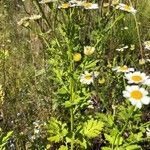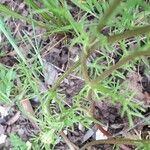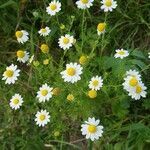Annuals, (5–)15–35(–90) cm, usually ill-scented. Stems green (sometimes red-tinged), usually erect, branched mostly distally or ± throughout, glabrous, glabrate, puberulent, or sparsely strigillose to strigoso-sericeous (glabrescent, hairs mostly medifixed) and gland-dotted. Leaf blades 25–55 × 15–30 mm, 1–2-pinnately lobed. Peduncles mostly (2–)4–6(–15) cm. Involucres 5–9 mm diam., ± villosulous to arachnose. Receptacles paleate mostly distally; paleae subulate to acerose 2–3+ mm (often gland-dotted). Ray florets 10–15, styliferous and sterile; corollas white, laminae 5–15+ mm. Disc corollas 2–2.5 mm (sparsely gland-dotted). Cypselae 1.3–2 mm, ribs ± tuberculate (furrows often gland-dotted); pappi 0. 2n = 18.
Annual herb to c. 60 cm high, strongly odorous when crushed, usually sparsely to moderately hairy. Leaves to c. 5 cm long, 2-or 3-pinnatisect. Capitulum 15–25 mm diam.; peduncle with an untidy indumentum of mainly divergent to spreading hairs distally at anthesis; involucre 4–5 mm long, hairy; inner bracts with hyaline extension 0.5–1 mm long; paleae arising only from upper half of receptacle, linear to linear-lanceolate, 0.3–0.7 mm wide. Ray florets 10–15, sterile; ligule 5–9 mm long, white. Disc floret corolla 2–3 mm long, swollen at base. Achenes obovoid, 1.2–1.5 mm long, c. 0.8 mm wide, ±terete, usually tuberculate along ribs, sometimes nearly smooth. Pappus absent.
Herbs, annual, (15-)30-50 cm tall, fetid; stems erect, corymbosely branched, sparsely pubescent or subglabrescent. Leaves sessile; leaf blade ovate-oblong, 1.5-6 × 0.5-3 cm, 2-pinnatisect; ultimate segments narrowly linear. Capitula terminal, solitary, long pedunculate, 1-2 cm in diam. Involucre hemispheric; phyllaries in 3 rows, oblong, scarious margin narrow, apex obtuse. Ray florets white; lamina 5-14 × 3-6 cm, elliptic. Disk florets yellow, tubular, 5-lobed. Achenes oblong-turbinate, 1-1.5 mm, tuberculate, obscurely 8(-10)-ribbed. Corona absent. Fl. and fr. Jun-Jul. 2n = 18.
Taprooted, usually subglabrous, malodorous annual 1-9 dm; lvs 2-6 cm, 2-3 times pinnatifid, with narrow segments; heads short-pedunculate, the disk 5-10 mm wide, becoming ovoid or short-cylindric at maturity; invol sparsely villous; rays mostly 10-16, sterile and usually neutral, white, 5-11 mm; receptacle chaffy only toward the middle, its firm, narrow, subulate bracts tapering to the apex; achenes subterete or nearly quadrangular, obscurely ca 10-ribbed, strongly glandular-tuberculate; 2n=18. Fields and waste places; native of Europe, now a cosmopolitan weed. (Maruta c.)
Annual herb, up to 0.6 m high, foetid. Leaves alternate, sessile; blade ovate to elliptic in outline, 1-3x pinnate, ultimate segments narrowly linear. Heads terminal, solitary on long peduncles, radiate. Involucral bracts in several rows, imbricate. Receptacle conical; paleae linear, acute. Flowers: ray florets usually without styles, white; disc florets bisexual, yellow; Feb. Fruit with cypsela oblong, ribbed and tubercled, glabrous. Pappus absent.
Annual herb, up to 0.6 m high, foetid. Leaves alternate, 1-3x pinnate, ultimate segments narrowly linear. Capitula radiate, solitary on long peduncles. Receptacle conical, paleate, paleae linear, acute. Ray florets usually without styles, white. Disc florets yellow. Flowering time Dec.-May. Pappus absent or of minute scales. Cypselae oblong, ribbed and tubercled.
Annual herb, up to 0.6 m high, foetid. Leaves 1-3 times pinnate, ultimate segments narrowly linear. Heads solitary on long peduncles. Ray flowers usually without styles. Receptacular paleae linear, acute. Achenes ribbed and tubercled. Flowers with white rays, disc yellow.
A small annual herb. It grows 20-60 cm high. It has a bad smell. The stems are erect and may or may not be branched. The leaves are divided 1-3 times. The last segment is narrow and pointed. The flowers are in daisy like heads. They are white and at the end of the plant.









